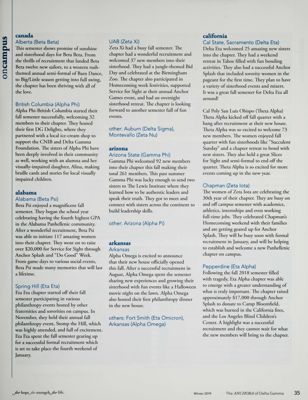
Gamma Theta
University of Florida
- Founding Date
- Apr 9th, 1949
The University of Florida traces its origins to 1853, when the East Florida Seminary, the oldest of the University of Florida's four predecessor institutions, was founded in Ocala, Florida. On January 6, 1853, Governor Thomas Brown signed a bill that provided public support for higher education in Florida. Gilbert Kingsbury was the first person to take advantage of the legislation, and established the East Florida Seminary, which operated until the outbreak of the Civil War in 1861. The East Florida Seminary was Florida's first state-supported institution of higher learning. James Henry Roper, an educator from North Carolina and a state senator from Alachua County, had opened a school in Gainesville, the Gainesville Academy, in 1858. In 1866, Roper offered his land and school to the State of Florida in exchange for the relocation of the East Florida Seminary to Gainesville. The City of Gainesville, led by its Mayor William Reuben Thomas, campaigned to be home to the new university, and was selected on July 6, 1905. The new University of the State of Florida was legally created, but operated on the campus of the old University of Florida in Lake City until the first buildings on the new campus in Gainesville were complete. Classes began on the new Gainesville campus on September 26, 1906, with 102 students enrolled. In 1909, the school's name was simplified from the "University of the State of Florida" to the "University of Florida." In 1924, the Florida Legislature mandated women of a "mature age" (at least twenty-one years old) who had completed sixty semester hours from a "reputable educational institution" would be allowed to enroll during regular semesters at the University of Florida in programs that were unavailable at Florida State College for Women. Before this, only the summer semester was coeducational, to accommodate women teachers who wanted to further their education during the summer break. In late August 1948, Mildred Baynard, Kappa-Nebraska, walked into the Delta Gamma Executive Offices in Columbus, Ohio, asking to speak with Executive Secretary Roberta Abernethy. The international headquarters was only six years old, very small, with two collegians and a staff member working that summer day. Mildred had a mission, it being “that Delta Gamma must not wait any longer to enter the University of Florida, in Gainesville.” The university had been all male, and fraternities were well established with large beautiful houses. In 1947 the university allowed four sororities to colonize with a plan to add four more the following year. Delta Gamma was not one of these eight sororities and Mildred felt Delta Gamma must act immediately. She was certain, and correct, that the female enrollment had increased sufficiently and she promised unlimited support from herself and friend, Francis Harris, also Kappa-Nebraska. Roberta contacted Delta Gamma’s First Vice-President, Dorothy Wildasin, herself a woman of action where expansion was concerned, and the two agreed with the support offered by Frances and Mildred that it was the time to ac t. These two women were classmates at Nebraska in 1922 and when the fraternity needed transfers to University of Southern California to assist a new chapter, off they went to help. Now it was 25 years later and they were anxious to create a similar success story in Florida. Letters were written, visits were made, and a new colony was born. That first year 15 women were pledged which was comparable to the other chapters. Mildred and Francis had rented a house with room enough for 11 to live in. Dr. Eleanor Bode Brown, Epsilon-Ohio State, only one of three women on the faculty, offered to help. The two collegians working in the Columbus headquarters office that summer, volunteered to transfer for a semester and two Beta Sigma-Maryland members living in Florida transferred to the university and assisted in training and helping the colony get started. The success and popularity of this inaugural group followed. As first semester neared its close, enthusiastic DGs wanting to spend a “sunny semester in Florida” rallied to attend their second semester at the university. Two collegians from Alpha Rho-Ohio Wesleyan and three from Zeta-Albion were selected. With a little more than 10,000 students the ratio at the university was 11 men to each woman. Needless to say, social life was active. Because of this the women on campus crusaded for hours, asking an astounded Dean Brady to curtail some of the social activity. However, it was too late for seven of the original 15 pledges, for only eight women made their grades for initiation. Installation of Gamma Theta chapter and the initiation of eight collegians and 13 women from Gainesville, Tallahassee and St. Petersburg, who had accepted invitations to become alumnae initiates, participated in weekend events beginning on Friday evening, April 7, 1949. The colony was installed as a chapter on April 9, 1949, with Edith Taylor Smith, Alpha Beta- Swarthmore and Fraternity President, presiding. Delta Gamma alumnae within a 100-mile radius of Gainesville were invited to an installation day luncheon that included many 50- and 60-year members. Gamma Theta was grounded in Delta Gamma Fraternity and had created a heritage of “Hope” for a long and successful chapter on the campus of University of Florida. Four years later in 1953, the chapter house became the first permanent sorority house to be built on UF’s sorority row.
Chapter Information
04/09/1949












